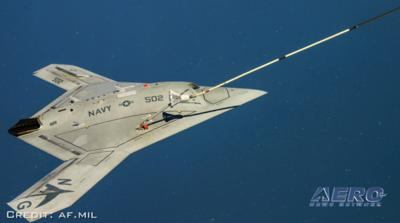Thu, Sep 14, 2017
Intelligence-Gathering A Possible Secondary Mission For The Aircraft
The U.S. Navy is working to finalize its MQ-25 drone program sometime in the next two years with a goal of operating unmanned aircraft off aircraft carriers that are capable of delivering fuel to other aircraft in flight.

Defense News reports that the first MQ-25 drones are set to deploy from the aircraft carriers Dwight C. Eisenhower and George H.W. Bush in 2019, but a deployment date in 2018 is also under considerations. But the Navy will have to make its business case for an earlier deployment.
The success of the program relies heavily on the Unmanned Carrier Aviation Mission Controls System (UMCS). The Common Control System (CCS) for the UMCS is being developed by the Strike Planning and Execution Systems office of the Naval Air Systems Command. Third-party developers will likely be given contracts for vehicle-specific capabilities, according to the report.
The GAO plans to spend in excess of $2 billion for the MQ-25 system. Contractors on the program include Northrop Grumman, General Atomics, Lockheed Martin and Boeing.
If the refueling mission proves successful, the MQ-25 could also be configured for intelligence gathering and surveillance, according to the report.
According to NAVAIR, the MQ-25 will be the first air system procured by the Navy's Unmanned Carrier Aviation Program Office. (PMA-268) It is comprised of three major architectural segments: an Air Segment (AS), a Control System & Connectivity (CS&C) Segment, and a Carrier (CVN) Segment.
AS– Includes the MQ-25 UAS, which is composed of the MQ-25A Stingray air vehicle and associated support and handling equipment including the deck handling system, spares and repair materials.
CS&C – Includes the Unmanned Carrier Aviation (UCA) Mission Control System (UMCS) and its associated communication equipment; the Distributed Common Ground Station-Navy (DCGS-N) mission support functionality; all network based interfaces and routing equipment required to control the Stingray; and all required modifications to existing networks and C4I system infrastructure to enable tasking, collection, processing, exploitation and dissemination (TCPED) of the Stingray’s ISR information.
CVN – Composed of CVN ships’ spaces allocated to UCA as well as installed ship systems and modifications necessary for interface with the Air and CS&C segments. CVN systems important to the MQ-25 include aircraft launch and recovery systems, data dissemination systems (including radio terminals and antennas), and deck operations systems.
(Image from file)
More News
Airbus Racer Demonstrator Makes Inaugural Flight Airbus Helicopters' ambitious Racer demonstrator has achieved its inaugural flight as part of the Clean Sky 2 initiative, a corners>[...]
A little Bit Quieter, Said Testers, But in the End it's Still a DA40 Diamond Aircraft recently completed a little pilot project with Lufthansa Aviation Training, putting a pair of >[...]
Line Up And Wait (LUAW) Used by ATC to inform a pilot to taxi onto the departure runway to line up and wait. It is not authorization for takeoff. It is used when takeoff clearance >[...]
Contributing To The Accident Was The Pilot’s Use Of Methamphetamine... Analysis: The pilot departed on a local flight to perform low-altitude maneuvers in a nearby desert val>[...]
From 2015 (YouTube Version): Overcoming Obstacles To Achieve Their Dreams… At EAA AirVenture 2015, FedEx arrived with one of their Airbus freight-hauling aircraft and placed>[...]
 Airbus Racer Helicopter Demonstrator First Flight Part of Clean Sky 2 Initiative
Airbus Racer Helicopter Demonstrator First Flight Part of Clean Sky 2 Initiative Diamond's Electric DA40 Finds Fans at Dübendorf
Diamond's Electric DA40 Finds Fans at Dübendorf ANN's Daily Aero-Term (04.23.24): Line Up And Wait (LUAW)
ANN's Daily Aero-Term (04.23.24): Line Up And Wait (LUAW) NTSB Final Report: Extra Flugzeugbau GMBH EA300/L
NTSB Final Report: Extra Flugzeugbau GMBH EA300/L Classic Aero-TV: 'Never Give Up' - Advice From Two of FedEx's Female Captains
Classic Aero-TV: 'Never Give Up' - Advice From Two of FedEx's Female Captains



